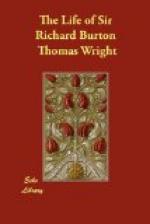One of the most curious features of the Nights is the promptitude with which everyone—porters, fishermen, ladies, caliphs—recites poetry. It is as if a cabman when you have paid him your fare were to give you a quatrain from FitzGerald’s rendering of Omar Khayyam, or a cripple when soliciting your charity should quote Swinburne’s Atalanta. Then in the midst of all this culture, kindliness, generosity, kingliness, honest mirth,—just as we are beginning to honour and love the great caliph, we come upon a tale[FN#448] with the staggering commencement “When Harun al Rashid crucified Ja’afar;” and if we try to comfort ourselves with the reflection that we are reading only Fiction, History comes forward and tells us bluntly that it is naked truth. Passing from this story, which casts so lurid a light over the Nights, we come to Abu Mohammed, Lazybones, the Arab Dick Whittington, whose adventures are succeeded by those of Ali Shar, a young man who, with nothing at all, purchases a beautiful slave girl—Zumurrud. When, after a time, he loses her, he loses also his senses, and runs about crying:
“The sweets of life are only for the mad.”
By and by Zumurrud becomes a queen, and the lovers are re-united. She is still very beautiful, very sweet, very pious, very tender, and she flays three men alive.
We need do no more than allude to “The Man of Al Yaman and his six Slave Girls,” “The Ebony Horse,” and “Uns al Wujud and Rose in Hood.”
The tale of the blue-stocking Tawaddud[FN#449] is followed by a number of storyettes, some of which are among the sweetest in the Nights. “The Blacksmith who could handle Fire without Hurt,” “The Moslem Champion,” with its beautiful thoughts on prayer, and “Abu Hasn and the Leper” are all of them fragrant as musk. Then comes “The Queen of the Serpents” with the history of Janshah, famous on account of the wonderful Split Men—the creatures already referred to in this work, who used to separate longitudinally. The Sindbad cycle is followed by the melancholy “City of Brass,” and a great collection of anecdotes illustrative of the craft and malice of woman.




